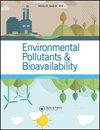锌冶炼废水灌溉土壤中锌和镉的固相形态
Q3 Chemical Engineering
引用次数: 9
摘要
摘要金属在污染土壤中的溶解度是控制金属对土壤环境的植物有效性和毒性作用的关键因素。金属离子在土壤溶液和固相之间的化学平衡决定了金属在土壤中的溶解度。因此,试图确定可能的固相(矿物),其控制锌冶炼厂废水灌溉土壤中Zn2+和Cd2+的溶解度。通过Baker土壤试验估算Zn2+(pZn2+)和Cd2+(pCd2+)的自由离子活性表明,与管井灌溉土壤相比,冶炼厂废水灌溉土壤中的金属离子活性更高。固相鉴定进一步表明,由于锌冶炼厂废水的长期灌溉,在被锌和镉高度污染的土壤中,Zn2+和Cd2+的自由离子活性分别受到Willimite(Zn2SiO4)与石英和八方辉石(CdCO3)平衡的溶解度的限制。然而,在管井灌溉土壤的情况下,与土壤Fe和可交换Cd平衡的franklinite(ZnFe2O4)可能分别控制土壤溶液中Zn2+和Cd2+的活性。高可溶性矿物willite和octavite的形成分别表明了锌和镉在冶炼厂废水灌溉土壤中的潜在生态风险。本文章由计算机程序翻译,如有差异,请以英文原文为准。
Solid phase speciation of Zn and Cd in zinc smelter effluent-irrigated soils
Abstract Solubility of metal in contaminated soils is a key factor which controls the phytoavailability and toxic effects of metals on soil environment. The chemical equilibria of metal ions between soil solution and solid phases govern the solubility of metals in soil. Hence, an attempt was made to identify the probable solid phases (minerals), which govern the solubility of Zn2+ and Cd2+ in zinc smelter effluent-irrigated soils. Estimation of free ion activities of Zn2+ (pZn2+) and Cd2+ (pCd2+) by Baker soil test indicated that metal ion activities were higher in smelter effluent-irrigated soils as compared to that in tubewell water-irrigated soils. Identification of solid phases further reveals that free ion activity of Zn2+ and Cd2+ in soil highly contaminated with Zn and Cd due to long-term irrigation with zinc smelter effluent is limited by the solubility of willemite (Zn2SiO4) in equilibrium with quartz and octavite (CdCO3), respectively. However, in case of tubewell water-irrigated soil, franklinite (ZnFe2O4) in equilibrium with soil-Fe and exchangeable Cd are likely to govern the activity of Zn2+ and Cd2+ in soil solution, respectively. Formation of highly soluble minerals namely, willemite and octavite indicates the potential ecological risk of Zn and Cd, respectively in smelter effluent irrigated soil.
求助全文
通过发布文献求助,成功后即可免费获取论文全文。
去求助
来源期刊
CiteScore
1.62
自引率
0.00%
发文量
0
审稿时长
1 months
期刊介绍:
Chemical Speciation & Bioavailability ( CS&B) is a scholarly, peer-reviewed forum for insights on the chemical aspects of occurrence, distribution, transport, transformation, transfer, fate, and effects of substances in the environment and biota, and their impacts on the uptake of the substances by living organisms. Substances of interests include both beneficial and toxic ones, especially nutrients, heavy metals, persistent organic pollutants, and emerging contaminants, such as engineered nanomaterials, as well as pharmaceuticals and personal-care products as pollutants. It is the aim of this Journal to develop an international community of experienced colleagues to promote the research, discussion, review, and spread of information on chemical speciation and bioavailability, which is a topic of interest to researchers in many disciplines, including environmental, chemical, biological, food, medical, toxicology, and health sciences.
Key themes in the scope of the Journal include, but are not limited to, the following “6Ms”:
Methods for speciation analysis and the evaluation of bioavailability, especially the development, validation, and application of novel methods and techniques.
Media that sustain the processes of release, distribution, transformation, and transfer of chemical speciation; of particular interest are emerging contaminants, such as engineered nanomaterials, pharmaceuticals, and personal-care products.
Mobility of substance species in environment and biota, either spatially or temporally.
Matters that influence the chemical speciation and bioavailability, mainly environmentally relevant conditions.
Mechanisms that govern the transport, transformation, transfer, and fate of chemical speciation in the environment, and the biouptake of substances.
Models for the simulation of chemical speciation and bioavailability, and for the prediction of toxicity.
Chemical Speciation & Bioavailability is a fully open access journal. This means all submitted articles will, if accepted, be available for anyone to read, anywhere, at any time. immediately on publication. There are no charges for submission to this journal.

 求助内容:
求助内容: 应助结果提醒方式:
应助结果提醒方式:


